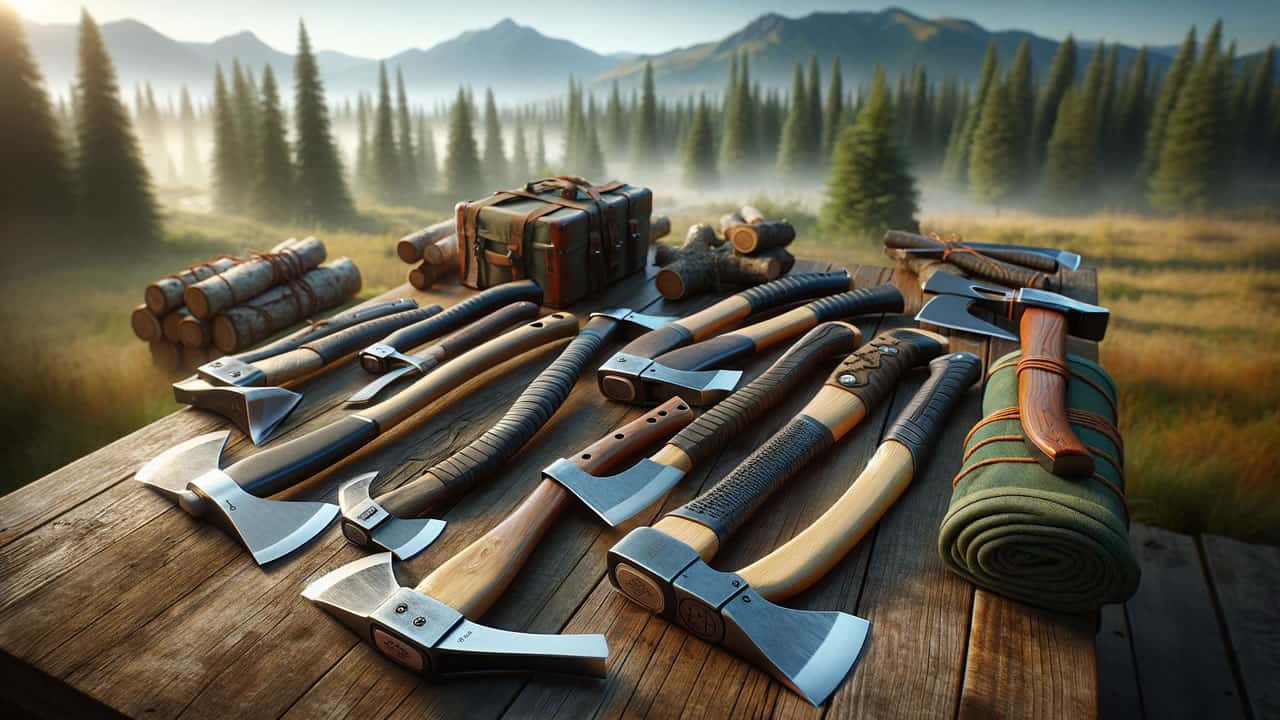When it comes to outdoor adventures, whether it’s a camping trip, a hiking excursion, or a survival challenge, having the right tools can make a significant difference. Among these tools, the axe stands out as a versatile and essential item. However, choosing the perfect axe isn’t as straightforward as it seems. This guide aims to simplify this choice, helping you select an axe that not only suits your needs but also enhances your outdoor experience.
Understanding the Types of Axes
1. The Hatchet
The hatchet is a small, lightweight axe designed for portability and ease of use. Ideal for backpackers and campers, it’s perfect for light chopping and splitting small logs for firewood. Its compact size makes it a great companion for short-term camping trips.
2. The Felling Axe
Larger and heavier than a hatchet, the felling axe is designed for cutting down trees. It has a sharp, thin blade that cuts deep into wood, making it efficient for felling small to medium-sized trees. It’s more suitable for forestry work and not recommended for casual camping due to its size and weight.
3. The Splitting Maul
The splitting maul is specifically designed for splitting logs along the grain. It has a broader head and a heavier weight, making it easier to split wood with less effort. This type of axe is ideal for preparing firewood at a campsite but is generally too heavy for long-distance hiking.
4. The Tomahawk
The tomahawk is a lightweight, single-handed axe with a rich history. Known for its versatility, it can be used for chopping, carving, and even as a throwing tool. It’s more suitable for skilled users who are familiar with its unique balance and handling.
5. The Multipurpose Axe
These are modern axes designed with outdoor enthusiasts in mind. They often come with additional features like a hammerhead or a built-in saw, making them a great all-in-one tool for camping and survival situations.
Factors to Consider When Choosing an Axe
Weight and Length
The weight and length of the axe should correspond to your physical strength and the nature of your activities. A heavy axe can be more efficient in chopping, but it’s also more tiring to carry and use, especially on long hikes. Conversely, a lighter axe is easier to handle but may require more effort in chopping.
Blade Quality
The material and quality of the blade determine the axe’s durability and efficiency. High carbon steel is a popular choice due to its sharpness and longevity. Ensure the blade is well-tempered to withstand the rigors of outdoor use.
Handle Material
Axe handles are typically made of wood, fiberglass, or composite materials. Wooden handles offer a traditional feel and good shock absorption but can be prone to damage. Fiberglass and composite handles are more durable and resistant to weather but may not provide the same comfortable grip as wood.
Balance
A well-balanced axe feels comfortable in your hands and makes chopping more efficient. The balance point should be near the axe head. Test different axes to find one that feels natural and easy to swing.
Safety Features
Look for axes with safety features like non-slip grips and overstrike guards. These features are especially important for beginners and can help prevent accidents.
Using the Axe for Different Outdoor Activities
Camping
For camping, a hatchet or a small multipurpose axe is usually sufficient. These axes are ideal for chopping firewood, making kindling, and other campsite tasks.
Hiking and Backpacking
When hiking or backpacking, weight is a crucial consideration. A lightweight hatchet or tomahawk is advisable. These tools can be easily attached to your backpack without adding much weight.
Survival Situations
In survival situations, a multipurpose axe with additional features like a hammer or saw can be invaluable. These axes can assist in building shelters, procuring food, and ensuring your safety in the wilderness.
Forestry Work
For forestry work, a felling axe or a splitting maul is more appropriate. These axes are designed for heavy-duty tasks like felling trees and splitting large logs.
Tips for Axe Care and Maintenance
- Sharpening: Regularly sharpen your axe to maintain its efficiency. Use a file or sharpening stone, following the original angle of the blade.
- Cleaning: Clean the blade after each use. Wipe off sap and debris, and apply a light coat of oil to prevent rust.
- Storage: Store your axe in a dry place. If it has a wooden handle, avoid extreme temperatures and humidity, which can cause the wood to crack or warp.
- Handle Care: Inspect the handle regularly for cracks or splinters. A damaged handle can be dangerous and should be replaced immediately.
- Safety: Always use your axe with care. Ensure a clear swinging area and wear appropriate safety gear like gloves and eye protection.
Conclusion
Choosing the right axe for your outdoor adventures is a balance of understanding the different types, considering your personal needs, and ensuring safety and maintenance. Whether you’re a camper, hiker, or a survival enthusiast, the right axe can be your most reliable companion. Remember, the best axe is the one that suits your activity, feels right in your hands, and is well-maintained for longevity and safety. Happy chopping!
